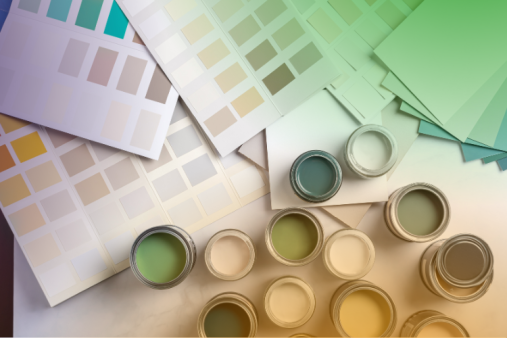How to Paint Skirting Boards: A Step-by-Step Guide
Painting skirting boards is one of those finishing touches that can completely refresh a room — whether you're updating tired woodwork or switching to a modern colour scheme. With a bit of preparation and the right tools, it's a straightforward DIY task that can make a big impact.
Materials & Tools You'll Need
-
Dust sheets or old towels
-
Masking tape or decorator’s tape
-
Sugar soap or mild detergent
-
Sandpaper (120–180 grit) or sanding block
-
Tack cloth or vacuum with brush attachment
-
Paint (wood and metal paint or eggshell/satinwood for interiors)
-
Primer or undercoat (if needed)
-
Paintbrush (angled brush is best for edges)
-
Small roller (optional, for wider boards)
-
Filler (for gaps or dents)
-
Flexible caulk (for wall/skirting gaps)
-
Putty knife
-
Damp cloth
Preparation Time:
-
Cleaning & filling: 30–60 minutes
-
Masking up: 15–30 minutes
-
Drying time between coats: 4–6 hours (check tin for exact timing)
-
Total time (over 1–2 days): 4–8 hours of active work
Step-by-Step Instructions
Step 1: Clear the Area
Move furniture away from the walls and lay dust sheets to protect your flooring. Tape the edges of the floor and wall around the skirting with masking tape to prevent paint bleed.
Step 2: Clean the Skirting Boards
Use sugar soap or a mild detergent solution to remove dust, grease, and grime. Wipe down with a damp cloth and let dry fully before moving on.
Step 3: Fill Any Gaps or Holes
Use a wood filler to patch dents or chips, and apply decorators’ caulk to seal any gaps between the skirting and wall. Smooth with a putty knife and allow to dry as per the product instructions.
Step 4: Sand the Surface
Lightly sand the skirting to help the new paint adhere better. Focus especially on any glossy or uneven areas. Wipe away all dust with a tack cloth or vacuum cleaner.
Step 5: Apply Primer or Undercoat (if needed)
If your skirting is bare wood or has been previously varnished or stained, apply a primer or undercoat. This step ensures even colour and long-lasting results. Let it dry fully before painting.
Step 6: Paint the Skirting Boards
Use an angled brush for control along the top edge, and a wider brush or small roller for the flat face. Apply in smooth strokes, brushing in the direction of the wood grain. Avoid overloading the brush.
Let the first coat dry fully before applying a second — typically 4–6 hours, but refer to your paint tin for accurate times.
Step 7: Apply a Second Coat
Most skirting will need two coats for a durable, even finish. Lightly sand between coats if needed for an ultra-smooth result.
Step 8: Remove Tape & Tidy Up
Once the final coat is dry to the touch, carefully remove the masking tape. Allow full curing time before moving furniture back — usually 24 hours for gentle use and up to 7 days for full hardness.
Drying Times (Typical Guide)
| Product Type | Touch Dry | Recoat Time | Fully Cured |
|---|---|---|---|
| Water-based satin/eggshell | 1–2 hours | 4–6 hours | 5–7 days |
| Oil-based gloss | 6–8 hours | 16–24 hours | 7–10 days |
Always check the manufacturer's instructions on your paint tin.
10 Frequently Asked Questions About Painting Skirting Boards
1. Do I need to sand skirting boards before painting?
Yes, a light sanding removes gloss and helps new paint stick. It also smooths out imperfections for a cleaner finish.
2. Can I paint skirting boards without removing them?
Absolutely. Most people paint them in place. Just mask off the floor and wall carefully and take your time with edges.
3. What type of paint should I use?
Use a durable wood and metal paint — typically satinwood, eggshell, or gloss. Satinwood offers a modern low-sheen finish, while gloss gives a more traditional high-shine look.
4. How do I stop paint bleeding under the masking tape?
Seal the tape edge by brushing a thin layer of the wall colour or clear base coat over the tape line before painting the skirting.
5. Should I use a brush or a roller?
A brush gives better control for edges and detail, while a small foam roller can be used on wider flat surfaces for an ultra-smooth finish.
6. Can I paint over varnished or stained wood?
Yes, but you must sand and prime first. A good adhesion primer is essential to ensure the paint sticks.
7. What’s the best way to deal with gaps between skirting and wall?
Use a flexible decorators’ caulk. Apply with a caulking gun, smooth with a wet finger or sponge, and let dry fully before painting.
8. Do I need to remove old paint before repainting?
Only if it's flaking or very uneven. Otherwise, clean, sand lightly, and paint over it using a suitable undercoat if needed.
9. How long should I wait before moving furniture back?
Wait 24 hours before placing furniture back against the skirting and up to 7 days before cleaning or applying any pressure to the paint.
10. Can I use masking tape on freshly painted walls?
Wait at least 24–48 hours after painting walls before applying tape. Otherwise, you risk peeling off fresh paint.






